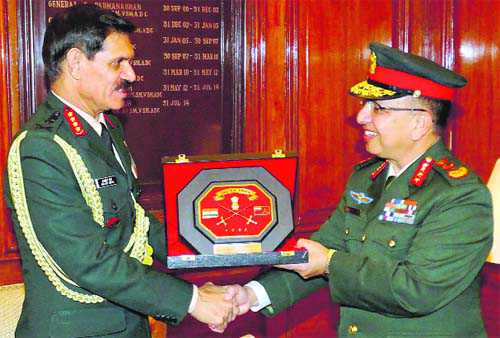
The two army chiefs played a behind-the-scenes role in lifting of the blockade
Nepalese Prime Minister KP Sharma Oli’s self-congratulatory declaration during his visit to New Delhi last week was that his main mission was to remove misunderstandings (presumably over the Constitution). “No misunderstanding exists” he asserted at the end of the visit. For India though the glass is still half empty. The two major as issues of citizenship and demarcation of boundaries are to be settled over the next three months by a political commission chaired by Foreign Minister Kamal Thapa. Despite initial grandstanding, Oli opted to visit India (before going to China). Though high on optics, the visit produced no substantive new agreements. These must await settlement of residual constitutional issues. More than 50 persons, mostly Madhesis, lost their lives during the five-month long trade and transit blockade that severely hurt the people and resulted in a rampant black market. This ‘misunderstanding’ is by far the most serious bilateral incident in recent memory, causing an unprecedented anti-India sentiment, some stoked, but mostly spontaneous.As Oli blinked first, one Nepali columnist called it a victory for India. Clearly it was a failure of diplomacy. Constitutional inequities for Madhesis were resolvable through negotiations. There was no need for any of the defiance and trading of harsh words at the UN Human Rights Council at Geneva. Nepal invoking its strategic autonomy was a legitimate reaction to India’s belated and heavy-handed intervention on behalf of the Madhesis in full public glare. Both sides made mistakes: Kathmandu bulldozed the constitution ignoring Madhesi concerns. It even withdrew the rights granted to them in the interim constitution. New Delhi indelicately demanded the historical wrongs against the Madhesis be corrected. Given the open border, the unrest was inimical to India’s security interests. Nepal’s geostrategic location perched between two Asian giants makes it a natural avenue from the north to the strategic heartland of the Indo-Gangetic Plains.Unlike in 1989/90, this blockade evoked a strong sense of nationalism and independence among Nepalis especially in the Kathmandu valley. India was blamed for the shortages in cooking gas, fuels and other consumer goods. People were assured by the government that alternative sources of supply would be found, notably from China, which proved to be a big disappointment. Barring a few days of petroleum products supply, little else came from the North. The usual China card could not be played as the Khasa trading route has been out of commission since the earthquake.The Indian establishment feels that its intervention, though late, was justified. It had a clear aim: empowering Madhesis at an affordable cost. ‘We are on the right side of history, the anti-India feeling will dissipate and people will soon forget about it’ feels one policy maker. This is the crucial X factor. How badly damaged are India-Nepal relations and how deeply scarred are Nepali sentiments towards India? External Affairs Minister Sushma Swaraj reminded the Nepali delegation accompanying Oli of Prime Minister Narendra Modi’s hearts-and-minds capturing speech in their Parliament in August 2014. She said that no Indian Prime Minister had visited Nepal for 17 years till Mr Modi and added that she was instrumental in reviving the Joint Ministerial Commission after 23 years. Applying balm to the troubled upshot of the blockade, without mentioning it, she pointed out that India does not take a Big Brother attitude but one of an Elder Brother.Swaraj seemed to have realised that the stand-off was fetching diminishing returns. Kamal Thapa’s three visits to New Delhi did not see any concrete steps for meeting the two major Madeshi demands.Only after Oli expressed a sense of urgency to visit India was he coaxed into getting the House to pass amendments by a two thirds majority. The passage of the amendments was the open sesame to lifting the blockade and his red carpet welcome in India. This was reinforced by the appointment of a political commission under Thapa to address residual constitutional issues especially demarcation of boundaries.A visit that did not attract much attention was that of Nepal Army Chief, Gen Rajendra Chhetri. He arrived two weeks before his Prime Minister even as the blockade was in place and constitutional amendments still in the pipeline. Indian Army Chief Gen Dalbir Singh and Gen Chhetri, besides being friends, are honorary Generals in each other’s armies, a tradition that took root four decades ago and is the bedrock of special relations between the two armies though Kathmandu views the use of this term as politically incorrect. The two Army Chiefs played a crucial behind-the-scenes role in fast-tracking the constitutional amendments and lifting the blockade.As the families of 40,000 Gorkha soldiers and more than 1 lakh ex-servicemen in Nepal were also affected, early lifting of the blockade was necessary. During the economic blockade in 1989-90 (officially the Trade and Transit Treaty had lapsed and not renewed except for keeping open two transit points) then Army Chief, Gen VN Sharma informed Prime Minister Rajiv Gandhi of his concern for families of Gorkha soldiers. Similar concerns were expressed in 1986 during the Gorkhaland movement in the Darjeeling hills.Nepal was afflicted by a decade-long civil war followed by a decade of political instability culminating in a terrible earthquake which triggered the resolve to complete the constitution but without the necessary consensus. A stagnating economy plummeted due to the madness of the blockade. Though India will be in a wait and watch mode till the Thapa Commission submits its report, it must facilitate Nepal’s economic development and prosperity. New actors and scenarios are emerging on the political landscape. These require New Delhi to jolt itself out of old mindsets. Rebuilding trust and friendship between the two states and people is vital for India’s Neighbourhood First policy. And Nepal is certainly among the first.The writer was commissioned in Gorkha Rifles and was the GOC, Indian Peace Keeping Force, Sri Lanka.
